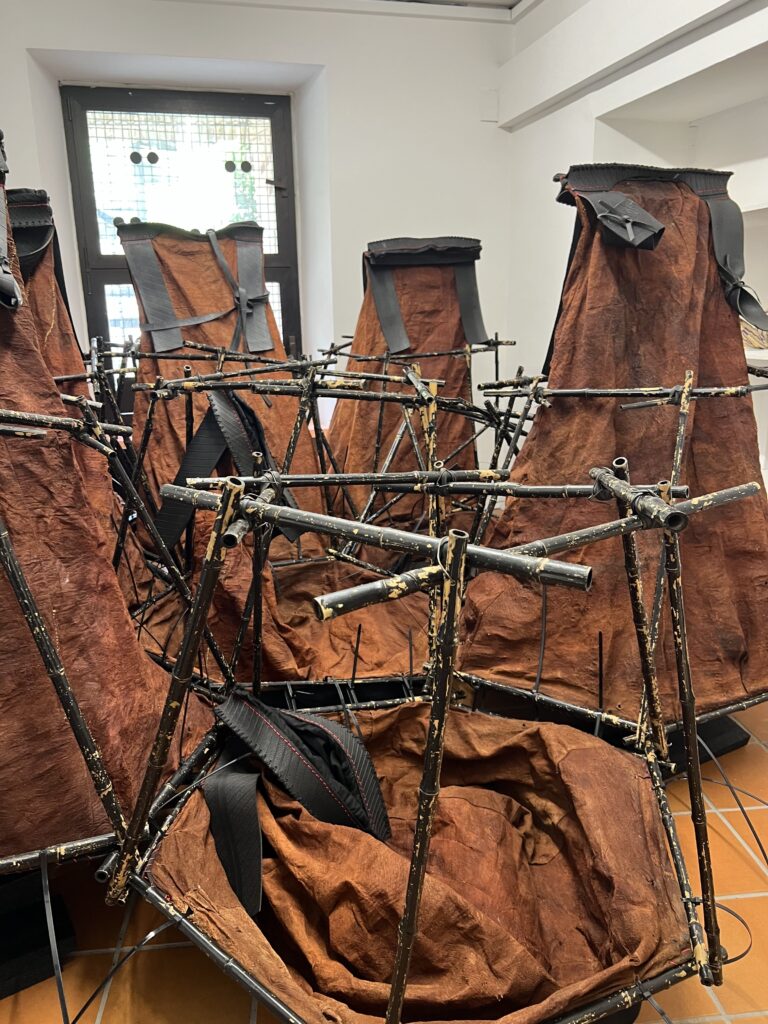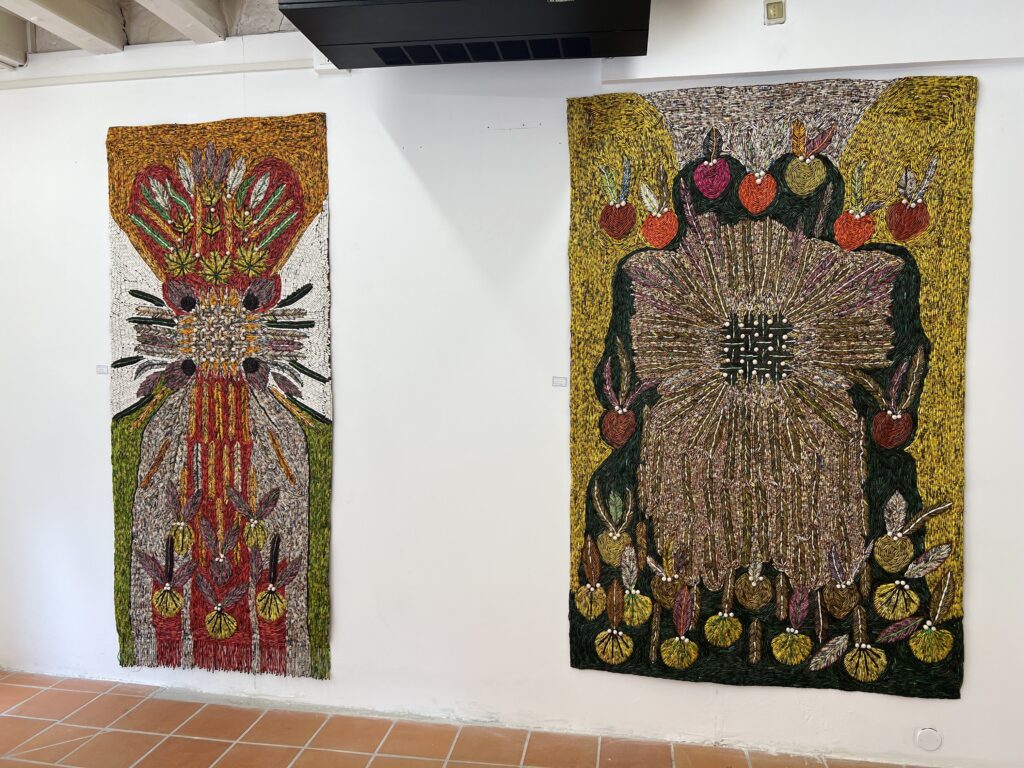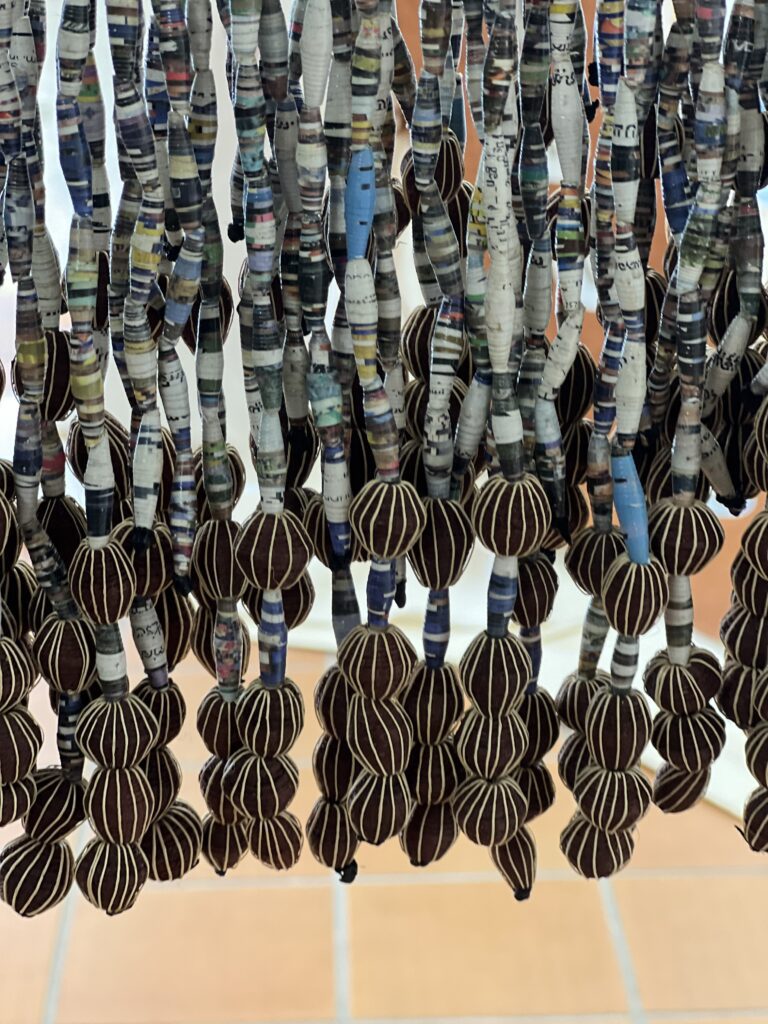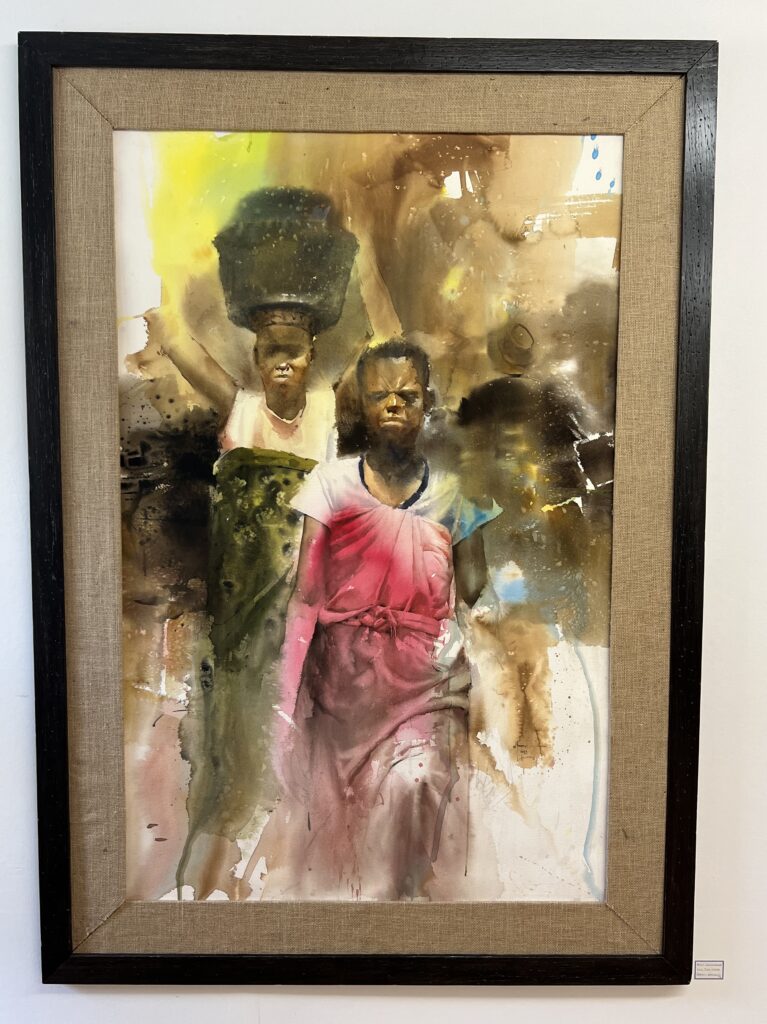After installing my work at the Grenada Pavilion, at the Venice Biennale, I visited several national pavilions. This is from my visit to the Ugandan Pavilion.
Uganda is an East African landlocked country that gained independence from the UK in 1962 and became a republic the following year.
Under the theme WAN ACEL | TULIBAMU | TURIBAMWE | WE ARE ONE, the pavilion of the Republic of Uganda at the Bragora Gallery, Castello, showed the work of the 26-person Artisan Weavers’ Collective and individual artists Sana Gateja, Taga Nuwagaba, Xenson Ssenkaaba, Jose Hendo, and Odur Ronald. From the street, the glass façade snapshot wall hangings and an exquisite barkcloth creation of up-cycled and organic materials, of which a familiar colour caught my eye, thrusting me back to childhood. I fell in love with Hendo’s dress train of barkcloth bedecked with CDs.
Creating bark cloth from the Mutuba tree (Ficus natalensis) in Uganda, was inscribed on the UNESCO Representative List of the Intangible Cultural Heritage of Humanity in 2008. The terracotta colour lured me into the pavilion, and reignited a childhood memory of sleeping on a mattress filled with pokey coconut husk fibre (coir)—the same I suspect used for door mats. The barkcloth also reminded me of the thin fibrous ‘cloth’ which cushions the graaps of coconuts at the tops of the one tree in my yard, and, which on occasion I have used as natural canvas.
I made a beeline for a back room that threatened to burst at the seams from the power of a stunning geometric sculpture by Xenson Ssenkaaba, a multimedia artist who runs an artspace in Uganda. He explained his process and the forms created using bark cloth, bamboo and recycled tyres to represent childhood memories, resilience, conservation and the future. Despite the limited room size, his Bujulizi installation is flexible in both construction and concept—adapting from floor to ceiling as needed, and as exhibiting space permits. I was mesmerised.
Gateja utilised his goldsmith training to form intricate large scale works from recycled and sustainable paper beads, tiny sculptures that carry messages of hope for our environment. I read that after he introduced recycled beads in Uganda in 1990, thousands of women across the country have since benefitted from sustainable incomes based on this form of recycling.
The Artisan Weavers Collective’s mats and basketry were exquisitely made from paper beads and other materials, in vivid celebration of materials traditionally used by Ugandan artisans and craftsmen. Curator Elizabeth Acaye Kerunen showed that natural fibres, upcycled and recycled found items can populate contemporary art and defy the maddening restrictions of art in the Western world.
Nuwagaba’s vibrant watercolours and oils document changing landscapes of Uganda, and pays homage to totems—animal or plant symbols that represents a group of people with a common ancestral origin, while Ronald’s The Republic of Opportunities (2022), a collection of African passports replicated in beaten metal, spoke to me of limitations to travel across the African continent—there is no Flixbus or cross continent train system—opportunities lost and wasted because of colonial legacy and contemporary civil unrest, and finally, reminded me of Grenada’s CBI programme.
Uganda debuted its first pavilion at the 59th edition of the Venice Biennale in 2022. Then, as now in its second edition, the focus is on collective memory across wider Africa, explorations of shared humanity, and boasting Ugandan-ness to the world.
I felt at home and comforted by the work at the Uganda pavilion; it was familiar, but speaking its unique tongue, while transporting me from Venice to my childhood in its presentation. However, as I engaged with the Uganda artworks, I tried to ignore a familiar gnawing setting in. Promoting locally sourced materials to create housewares, packaging and unique artworks that exude Grenadian-ness is a long-festering thorn in my side. The Grenada Business and Agriculture Revitalisation Project (GBAR Project), initiated by USAID–Carana after Hurricane Ivan, trained 200 craft producers and organised a Buy Grenada Craft Fair to boost rural employment and link craft production with tourism. Despite the sector’s potential for high value-added products from materials sourced locally at moderate cost to produce functional and decorative items, under 4 design categories—Amerindian, Festival, Grenadian(a) and Heritage—aspirations for vibrant entrepreneurship and niche market participation are stymied by government indifference, fragmentation among stakeholders, and investment barriers for artisans.
In time to come, I hope that our artists and artisans can realise unique works from what exists—materially and historically—on Grenada. Just as grow what we eat, eat what we grow, stimulates food sustainability, create from what exists, can help stimulate art/artisanal sustainability. We have many stories to tell.
#nomanisanisland #grenadavenicepavilion #biennalearte2024 #foreignerseverywhere #StranieriOvunque #artstungingrenada #suelinlowchewtung #foreignerwithin @grenadapavilionvenice @artstungingrenada







